

Review: Size does matter
After a few days of messing around with the Eee, it's time to wrap up our review. I can already feel Fudo's fiery breath on my neck and there's no time to waste, so let's get down to business. In case you've missed our preview, check it out here, as we're skipping the introduction.
Getting Started
Let's start with the box, as you're probably going to get your Eee in it, unless you're one of those people who don't mind getting blood-stained notebooks without an AC adapter at bargain prices.
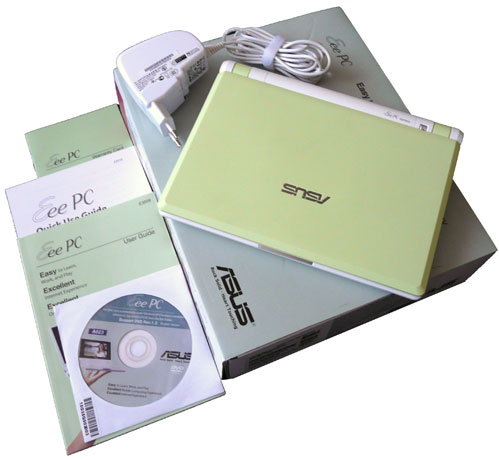
The box contains two user manuals, a comprehensive one and an abridged version, a warranty card, AC adapter, Support DVD and the Eee itself. The whole package is ridiculously small and looks pretty good. Your first task will be to stick the battery onto the Eee. The mechanism is very simple, yet sturdy. Once the battery pack clicks in it doesn't budge, it fits like a glove. This is nice to see, as many people would expect such a low-priced machine to be put together cheaply, but in this department it just feels like a pricey laptop. Rock solid, as Asus PR people would say.
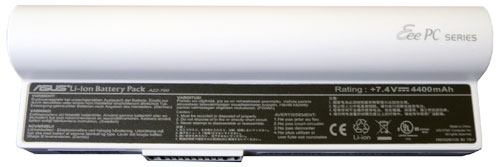
We tested the 4G Surf version, which ships with a 4-cell 4400mAh 7.4V Li-Ion battery. The non-Surf 4G and 8G come with a slightly more powerful 5200mAh battery and a Webcam. We managed to squeeze just under three hours of life out of our sample. Not bad, but not that great, either. While running demanding applications (if there are any that can run on the Eee) and using Wi-Fi, you can expect this time to drop. On the other hand, you should easily get more than three hours if you're using the Eee for light browsing, chat and writing emails.
Its AC adapter comes with a thin 3 meter (10 foot) cord, it has no "brick" and this helps. The power connector is located at the back and the thin, long cable makes your life easier if you have to use it while recharging. The biggest downside to the battery is its weight compared to the rest of the machine. When you fully open the screen it's on the brink of tipping over and this tends to annoy from time to time.
The Basics
Once you've charged it, push this silver thingy, count to 20-ish and you're set to go.
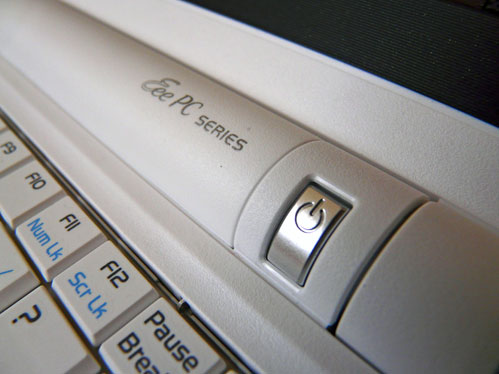
It's fast, and shutdown is even faster, well under 10 seconds if you've closed your apps prior to shutting down. Ah, in order to power up, you'll need to open the lid. The hinges are massive, they look like they could deal with a screen twice the size of the 7-inch dwarf on the Eee. Both the lid and the hinges look like they can take whatever you throw at them, the whole thing feels very durable, indeed.
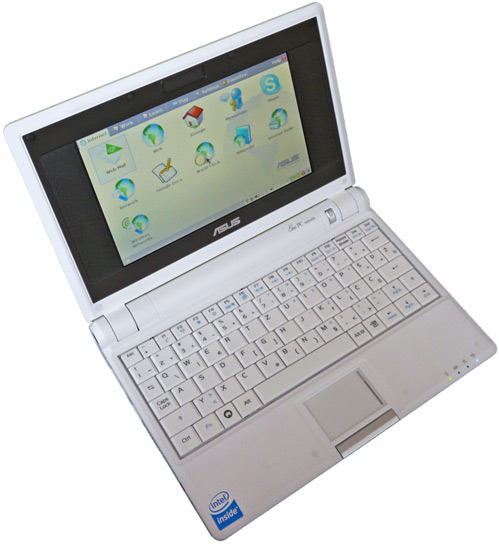
So here it is, the customized Xandros Linux in its full glory, or rather lack of it. We'll get back to it later on, let's talk hardware first. As we've said in our preview, the screen leaves much to be desired. Indoors it's not all that bad, but outside it disappoints, in spite of its LED backlight. This usually wouldn't be a huge drawback, but the Eee is touted as an ultra-portable PC and it's supposed to be used wherever your business takes you. The resolution is 800x480 and this is its biggest problem. Most Websites nowadays are designed for 1024, and an 800 pixel horizontal resolution will get you in trouble sooner or later. Fonts in some applications look huge, but you can try adjusting the font size if you don't mind looking at even smaller letters. The huge black bezel hides two speakers. They're adequate but not great.
Let's take a closer look at the rest of the machine. As you can see, on the left hand side you'll find the Ethernet connector, a useless modem connector, one USB, microphone in and line out. There's also a tiny ventilation opening in the middle, keep this in mind for later on.
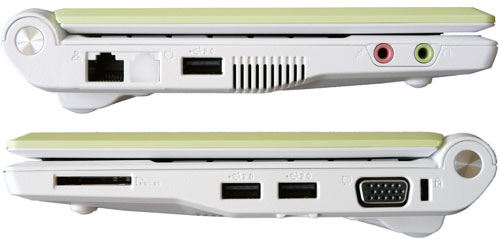
On the right side there's an SD/MMC memory card slot, two USB ports, a VGA out and finally, the Kensington lock slot. The battery is the thickest part of the whole package, the thickness ranges from 21mm at the front to 35mm at the back. This allows for a somewhat more comfortable typing position and better airflow while the Eee is on a flat surface, but the Eee is not intended to be used as a desktop.
You probably know the Eee's specs by now, but here's a quick reminder. It's powered by a 900 MHz Intel Celeron-M ULV 353 clocked at 630MHz (70MHz x 9), uses an Intel 910GML series chipset and Intel's GMA 900 IGP. The 512MB of DDR2 memory is expandable via a single memory slot, but you can forget about upgrading the 4GB SSD, as it is soldered onto the motherboard. Apart from the 100Mb Ethernet, it also has an Atheros 802.11b/802.11g wireless card, so connectivity shouldn't be an issue.
Might not sound like much by today's standards, but this is more than enough for the lean, customized Xandros Linux. Remember the ventilation opening on the side ? Well, here's a look at the bottom.
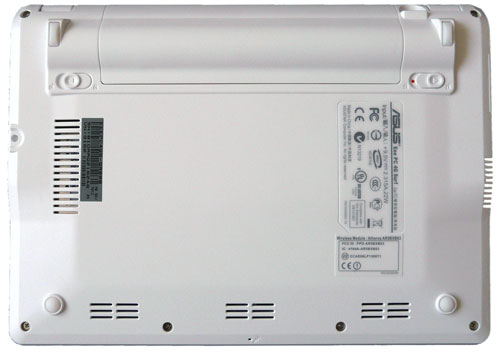
The rest of the ventilation openings are at the bottom. You don't expect such an underpowered machine to heat up much anyway, but if you're going to use it on your lap, you'll cover almost all the vents. Nothing serious, it will heat up a bit, just enough to keep you warm in these chilly spring days.
Now, let's take a look at the practical side of this contraption, ergonomics, ease of use, the works.
Keyboard and Touchpad
You're probably guessing that typing on such a compact keyboard is a bit strange and you're right. It takes a few days of getting used to and even then you should expect some typos.
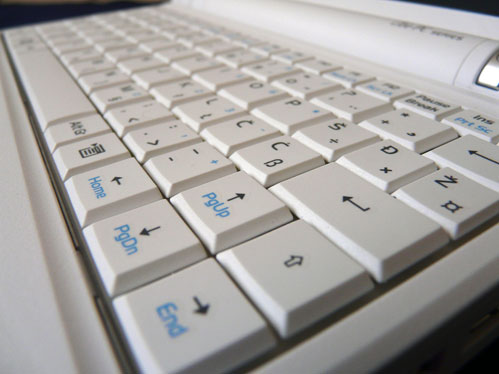
The layout is straightforward, apart from the position of the number keys. As you can see they've been moved one position to the left.
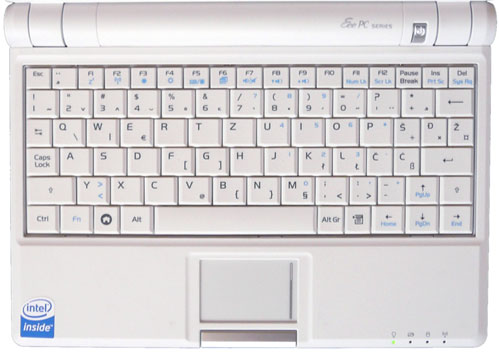
In spite of its small size, the keyboard is still rather good, but don't get your expectations too high. It is a bit cramped and it simply can't be any bigger on such a small notebook. It's just something we'll have to live with, not just on the Eee, but on similar products set to appear soon. Apart from the layout and size, the keyboard feels a bit fragile, in sharp contrast to the rest of the package.
The touchpad is tiny, as well, however, it is a lot easier to get used to. Its scroll area (on the right) is a bit too sensitive, but coming to grips with it is also just a matter of time. The same can't be said for the buttons, or should we say button. Asus decided to place both buttons under a single plastic bar and this wasn't their finest hour.
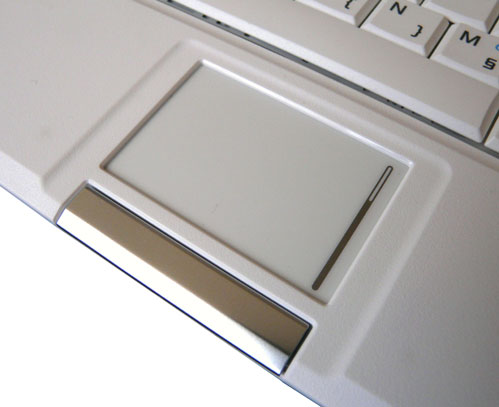
It's an unnecessary complication of an otherwise simple machine and the keys themselves demand too much pressure for our liking. Note the dark, circular stains on either side of the touchpad. The lid is cushioned by four tiny bits of black rubber, and they rub off against the white plastic in no time.
Size and Weight
Its dimensions are what makes the Eee so special and suitable for everyday use, so let's take a closer look. Weighing in at a mere 920g (2 lb ½ oz), it's a true featherweight. It measures just 225 × 165 × 21~35 mm (8.9 × 6.5 × 0.9~1.4 in) and, unlike most notebooks, it really can be compared to a book as far as size goes.
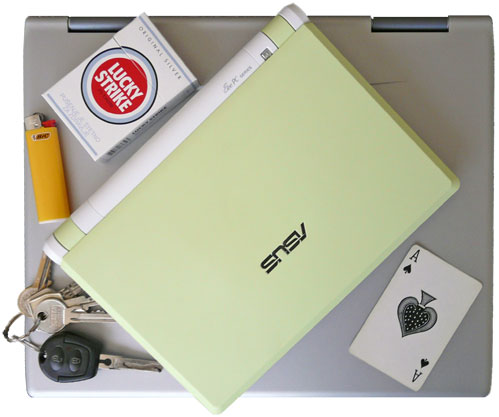
Here's how it looks on top of an old 15" notebook, with a few other everyday items.
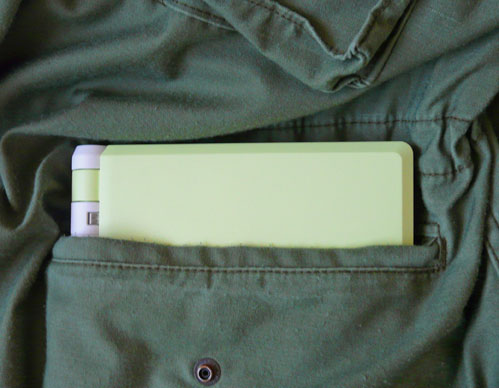
It can even fit into a large pocket, but we would advise against carrying it around like this. Remember the bargain priced notebook without an adapter I mentioned earlier?
In spite of its size, the Eee doesn't feel fragile. It doesn't bend, squeak, the lid doesn't twist and its battery fits in tightly. Its tough, matte plastic hides fingerprints and smear marks well. Due to its rough finish, we think it will stand up well against small scratches.
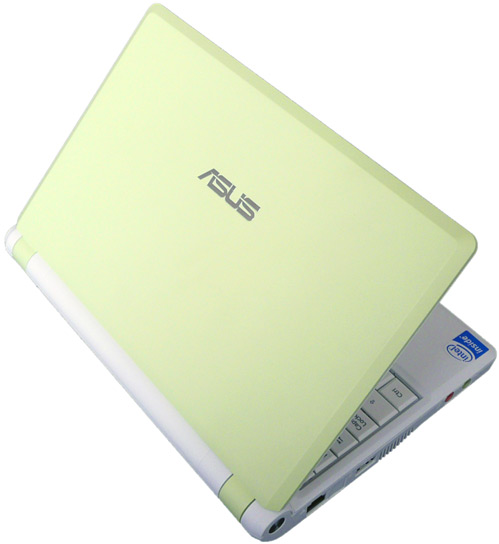
We believe Asus did the right thing when it comes to the choice of materials. It didn't try to make a cute, shiny toy which will scratch and wear easily. It opted for durability and robustness over looks, but the Eee still looks great and it will probably look just as good after months, if not years, of use.
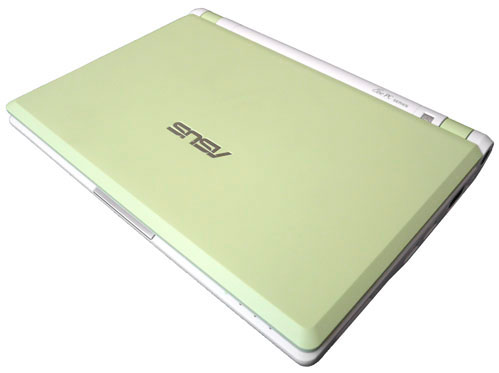
In our opinion, the only major aesthetic issue is the huge black bezel around the screen. It looks slightly better on a black Eee, but it's a bit too much for the white and lively colored Eee models.
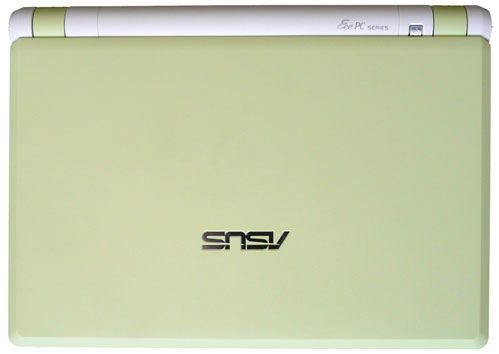
A cute toy, from any angle, wouldn't you agree ?
Operation and Conclusion
With the hardware side of the Eee out of the way, we can turn to its OS and applications. Asus opted for a heavily modified Xandros Linux distribution, but the Eee is also capable of running Windows XP and Asus will offer Eee with preinstalled XP soon, but at a somewhat higher price.
For now, let's stick to the Linux and see what it has to offer. In most respects it's an excellent choice, the only potential issue being Linux illiteracy among much of the Eee's target group. People are just used to Windows and there's nothing you can do about that. There is, however, no reason for concern. The Linux OS is very easy to use, it's fast and the Eee ships with a lot of useful software. This is one of its more impressive sides, as most people will find the installed software more than sufficient for their needs.
As you can see, the UI is very simple. Applications are grouped in four tabs located at the top. Apart from them, there are two more tabs, Settings and Favorites. What you're looking at is the silver theme, you can choose the blue, green and orange theme in the Settings tab. We think Asus could have and should have done a bit more on the design side. After all, many Eee customers will be students, kids and girls and they've been spoiled by mobile phones. Everybody is used to changing themes on their phones, customizing them and the UI on most modern phones just looks way better than Eee's UI. There's a lot of room for improvement here and we hope Asus will take the issue seriously, as the Eee is supposed to be a cool gadget and a more dynamic UI would help its image.
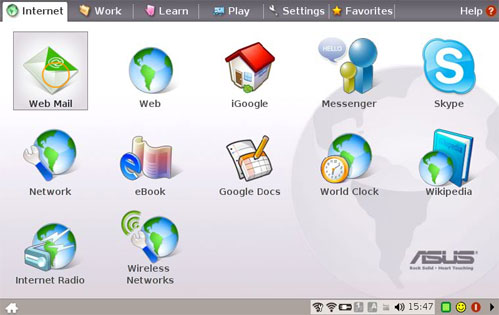
In the Internet tab, Mozilla Firefox and Thunderbird take care of your browsing and email needs, and Kontact PIM is included, too. Pidgin, a cross-platform IM client and Skype round up the communication package, and few people will ask for more. Setting up network connections and connecting to wireless networks is easy and intuitive.
We did run into some problems while reconnecting to wireless networks. When connecting via an Ethernet cable we noticed an odd problem. After accidentally disconnecting the cable, we had to reboot to reconnect. Nothing serious, though.
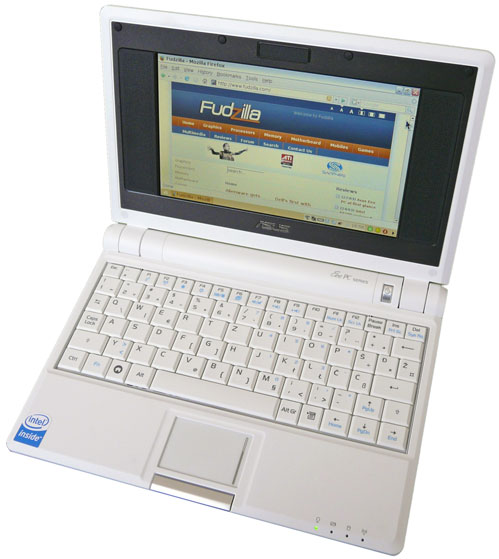
Here's how Firefox renders our site. It does rather well, but unfortunately this is not the case with many other sites which can't scale to 800px horizontal properly. You can scroll horizontally, it helps, but it's still a bit annoying.
Moving on to the Work tab now.
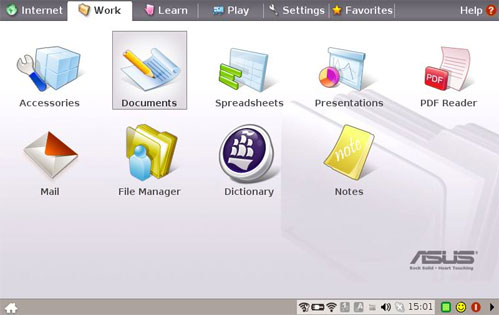
On the business side, you can count on Open office. It works, but it does seem to struggle a bit with the Eee's underpowered hardware and low screen resolution. It works a bit slower than other pre-installed apps, but it's still a very welcome addition to the software bundle. Thunderbird is also grouped in the Work tab.
Here are the Learn and Play tabs.
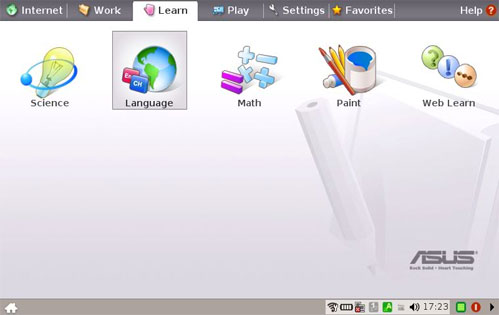
Not much to see in the learn tab, is there ?
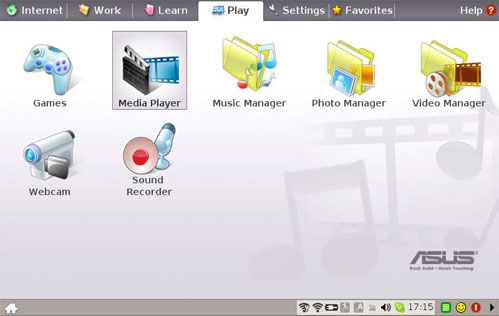
The Play tab offers you access to several games as well as Amarok audio player, Gwenview image viewer and SMplayer media player. All of them work great, but opening 8 megapixel (or higher) images is a bit slow, which is to be expected.
While the media players are good, it's important to address another issue now. Although the 4G model comes with a 4GB SSD, most of it is used by the OS and pre-installed apps. This leaves you with approx. 1.4GB for your stuff. If you go for the 2G model, you can expect 400MB of free space. Also, it doesn't feature the same software bundle as the 4G version, so we would strongly advise against it.
While 1.4GB doesn't seem like much nowadays keep in mind that the Eee has three USB ports for expansion, but there's a better solution still. It has an SD card slot and you should probably get yourself a 4GB or 8GB SD card as soon as you get your Eee. Unlike a USB drive, the SD card doesn't protrude from the slot and they're dirt cheap, around €20 for a 4GB and €40 for an 8GB card.
Conclusion
The Eee opened up a whole new market niche and we have to commend Asus for having the guts to step in and take the lead. Hence, there's really two ways of looking at it: as a concept and as an actual product and that's what I'm gonna do.
As a concept it's excellent. Simple, compact and affordable Eee-like notebooks on their way and they're probably here to stay. With plummeting memory prices and powerful energy efficient CPUs in the works, these machines will offer serious performance without compromising the basic idea behind the concept: low price coupled with small size. In a couple of years we will probably look back at the Eee as the granddaddy of an array of similar products. Asus took a gamble which eventually paid off; the trouble is, it could have done even better.
Now don't get me wrong, looking at it as a product, the Eee itself is a good machine. It's modestly priced, well put together and well thought through. A nice package, but it's far from ideal, so let's start with its shortcomings.
Its main problem is its 7-inch 800x480 screen which struggles with many Websites. Resolution isn't the only issue, the screen simply lacks acreage, making the Eee unpleasant to use frequently or for a long time. The keyboard is small, and you have to put your hands close together to use it effectively. This might be an issue for taller people. There is no way of making it any bigger, folks, it's a price you have to pay for the Eee's portability. And there's the touchpad, or touchpad button(s) to be exact; the single button solution wasn't a good idea.
The good points? Well, pretty much everything else. It's an affordable, ultra portable notebook capable of replacing a regular notebook in a number of undemanding tasks. This is the essence of mobile computing, keeping you in touch, letting you do part of your work on the road without the hassle of dragging along yet another heavy piece of luggage. It's robust, it looks great and thanks to a good software bundle it's ready to use out of the box. This might not mean a lot to enthusiasts, but it spares average consumers a lot of time and hassle.
All in all, we can recommend the Eee, but only if you can live with the 800px screen. If you're thinking about getting one, try it out for a couple of hours (or days) before making up your mind. If you think it's too small, don't rush. Asus will soon launch an 8.9-inch version.
Other than that, go for it, it's just a taste of things to come and you'll enjoy it.
